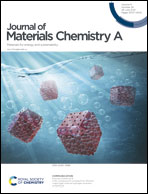Manganese phosphoxide/Ni5P4 hybrids as an anode material for high energy density and rate potassium-ion storage†
Abstract
Potassium-ion batteries (PIBs) that serve as low-cost and large-scale secondary batteries are regarded as promising alternatives and a supplement to lithium-ion batteries. Hybrid active materials feature the synergistic merits of individual components to overcome the sluggish kinetics of K+ insertion and structural deterioration of electrodes for PIBs. We report herein that a highly stable hybrid anode active material, an amorphous MnOxPy (a-MnOxPy) overlayer coating on a Ni5P4 film, is grown on carbon fabric cloth (CF) through a phosphidation reaction to obtain the integrated a-MnOxPy/Ni5P4/CF anode by simple phosphidation treatment. The optimized a-MnOxPy/Ni5P4/CFP anode delivers a high reversible specific depotassiation capacity of 398.8 mA h g−1 at 0.3 A g−1 after 100 cycles and acquires an excellent rate capability together with high cycling stability with capacities of 225.1 and 175.3 mA h g−1 at 5 and 10 A g−1 after 5000 cycles, respectively. The amorphous a-MnOxPy-45 overlayer and the porous features of the a-MnOxPy-45/Ni5P4 provide sufficient stress buffer and thus greatly accommodate large volume changes during potassiation/depotassiation. The hybrid interface between a-MnOxPy and Ni5P4 and favorable conductivity of the formed phosphides promote the charge transport and K+ storage kinetics. Also, the a-MnOxPy/Ni5P4/CF//K4Fe(CN)6 PIB full cell exhibits an initial discharge capacity of 343.9 mA h g−1 at 0.2 A g−1 and maintains 331.9 mA h g−1 after 100 cycles.



 Please wait while we load your content...
Please wait while we load your content...